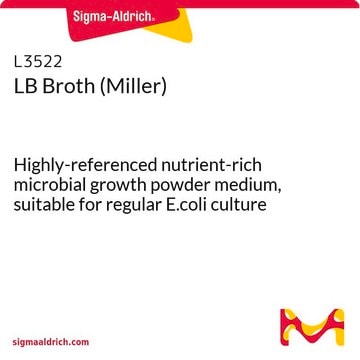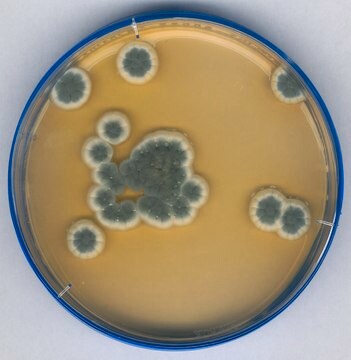N7519
Nutrient broth
Microbiologically tested, NutriSelect® Basic
Sign Into View Organizational & Contract Pricing
All Photos(1)
About This Item
UNSPSC Code:
41171607
NACRES:
NA.74
Recommended Products
Quality Level
sterility
non-sterile
form
powder
composition
Beef extract, 3.0 g/L
Peptone, 5.00 g/L
manufacturer/tradename
NutriSelect® Basic
technique(s)
microbiological culture: suitable
application(s)
bioburden testing
environmental
food and beverages
life science and biopharma
water monitoring
suitability
bacteria
Related Categories
Application
Nutrient broth has been used:
- for culturing Azospirillum brasilense
- for reconstitution of freeze dried Staphylococcus aureus culture
- for culturing Pseudomonas aeruginosa NCIMB 8626
Formula variant
With beef extract and peptone.
Preparation Note
Solve 8 g in 1 litre distilled water. Autoclave 15 minutes at 121°C.
Footnote
We offer two media types: the superior granulated GranuCult® and the cost-efficient powdered NutriSelect® culture media, depending on your needs.
The designations basic, plus, or prime are added to indicate the quality control level, from basic quality control to standard QC plus to prime for full regulatory compliance.
The designations basic, plus, or prime are added to indicate the quality control level, from basic quality control to standard QC plus to prime for full regulatory compliance.
Legal Information
GRANUCULT is a registered trademark of Merck KGaA, Darmstadt, Germany
NutriSelect is a registered trademark of Merck KGaA, Darmstadt, Germany
Storage Class Code
11 - Combustible Solids
WGK
WGK 3
Flash Point(F)
Not applicable
Flash Point(C)
Not applicable
Choose from one of the most recent versions:
Already Own This Product?
Find documentation for the products that you have recently purchased in the Document Library.
Customers Also Viewed
Incorporation and controlled release of a hydrophilic antibiotic using poly (lactide-co-glycolide)-based electrospun nanofibrous scaffolds
Kim K, et al.
Journal of Controlled Release : Official Journal of the Controlled Release Society, 98(1), 47-56 (2004)
Activity of acetyl-CoA carboxylase is not directly linked to accumulation of lipids when Chlorella vulgaris is co-immobilised with Azospirillum brasilense in alginate under autotrophic and heterotrophic conditions
Leyva LA, et al.
Annals of Microbiology, 65(1), 339-349 (2015)
Michele E Barbour et al.
International journal of nanomedicine, 8, 3507-3519 (2013-10-05)
Chlorhexidine (CHX) is an antimicrobial agent that is efficacious against gram-negative and -positive bacteria and yeasts. Its mechanism of action is based on cell membrane disruption and, as such, it does not promote the development of bacterial resistance, which is
Oskar A Palacios et al.
Microbial ecology, 77(4), 980-992 (2018-11-07)
The effect of three different nutritional conditions during the initial 12 h of interaction between the microalgae Chlorella sorokiniana UTEX 2714 and the plant growth-promoting bacterium Azospirillum brasilense Cd on formation of synthetic mutualism was assessed by changes in population growth
Beatriz Meza et al.
Research in microbiology, 166(2), 72-83 (2015-01-03)
Accumulation of intracellular ammonium and activities of the enzymes glutamine synthetase (GS) and glutamate dehydrogenase (GDH) were measured when the microalgae Chlorella vulgaris was immobilized in alginate with either of two wild type strains of Azospirillum brasilense or their corresponding
Our team of scientists has experience in all areas of research including Life Science, Material Science, Chemical Synthesis, Chromatography, Analytical and many others.
Contact Technical Service
